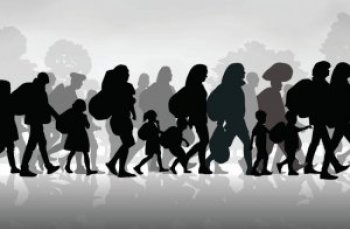

In line with an immigration policy based on merit and skill, not on family ties, the White house is pushing to end chain migration, a system “whereby one immigrant can bring in their entire extended families, who can bring in their families and so on.”
In response, as my colleague Mark Krikorian observed, “immigration expansionists and the media are doing their best to taint the phrase,” portraying it as a pejorative and nativist term.
Another dimension to this controversy was added recently by Senator Dick Durbin (D-Ill.), who told President Trump that the term “chain migration” was racist and offensive to African Americans: “I said to the president, ‘do you realize how painful that term is to so many people? African Americans believe they migrated to America in chains, and when you speak to chain migration it hurts them personally.'”
Perhaps it is time to take a deep breath and go back to the basics of migration theory. Let us refer to academic definitions of chain migration I picked up from a number of scholarly books on migration I happen to have around (emphasis added):
Even today, when our immigration laws favor family reunification, families most often arrive serially. This is now usually called chain migration, as the migrants, whether members of a nuclear or an extended family, follow one another as links in a chain.
Roger Daniels, Coming to America: A History of Immigration and Ethnicity in American Life (2002), p. 19.
One migrant stream may have an impact upon a second stream. The migration of an initial stream of people often encourages the migration of a second group; the innovators may be followed by family or friends at a different time, for example. This process is referred to as chain migration.
Paul Boyle, Keith Halfacree, and Vaughan Robinson in Exploring Contemporary Migration (1998) p. 36.
From the late nineteenth century, and well into the twentieth, a large proportion of migrants were being lured to foreign places, not by imperial dictates or explicit political upheaval, but by the suggestions and solicitations of their own kin. As migrants found prosperity and opportunity for themselves, they would often send for their relatives, or by their return home stimulate the need to emigrate in others. Chain migration often led to the formation of clusters of migrants from the same region…. Chain migration relied, not only on the new means of long-distance communication, and the speed and security of travel that the steamship introduced, but most crucially it depended on the authority and enthusiasm in the reports of life in the New World from friends and family members.
Nikos Papastergiadis in The Turbulence of Migration (2000), p. 28.
Chain migration does not carry a negative or racist connotation. It simply refers to a very well-known form of human mobility that is based on networks. People usually encourage, incite, sponsor, etc. other people they know or are related to to move to a country they are now based in.
The same idea (of someone who knows someone who knows someone etc.) lies behind what is called “snowball sampling” or “chain-referral sampling” in research methodology. It is “a non-probability (non-random) sampling method used when characteristics to be possessed by samples are rare and difficult to find … based on referrals from initial subjects to generate additional subjects. Therefore, when applying this sampling method members of the sample group are recruited via chain referral.”
The meaning of “chain” is crystal clear in both cases, leaving no room for wild interpretations. But we know very well that opportunistic readings abound, especially when political gains are involved.
Decreasing the level of legal immigration into the United States by limiting family immigration sponsorship to spouses and minor children (the list now also includes parents and siblings and adult sons and daughters) might not be to the liking of many. Opposition to such merit-based immigration policies is to be expected. But for contenders to impute racism where there is none is not only wrong, it is harmful to the true victims of racism.
Click HERE to view more.
You can publish this article on your website as long as you provide a link back to this page.

Be the first to comment